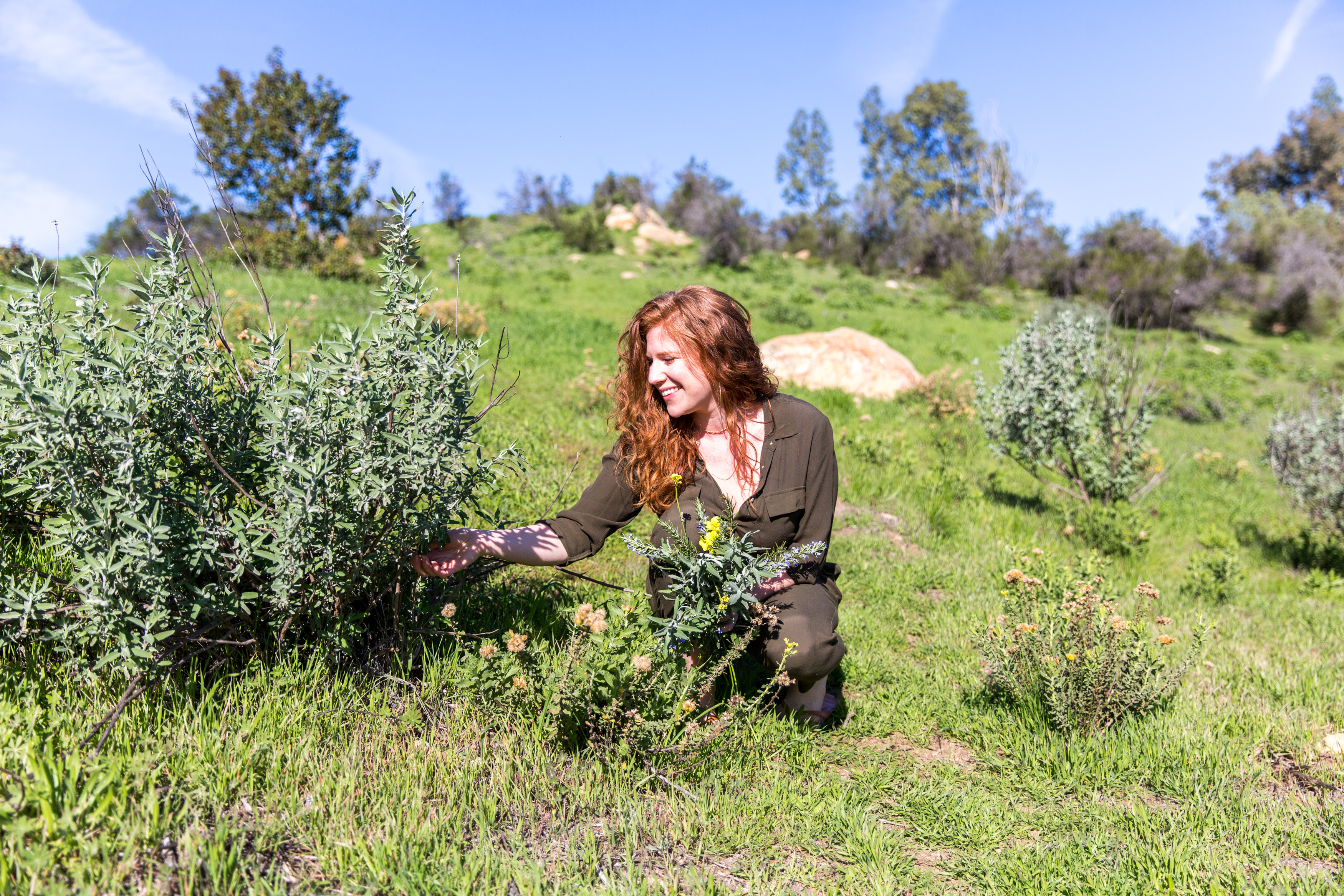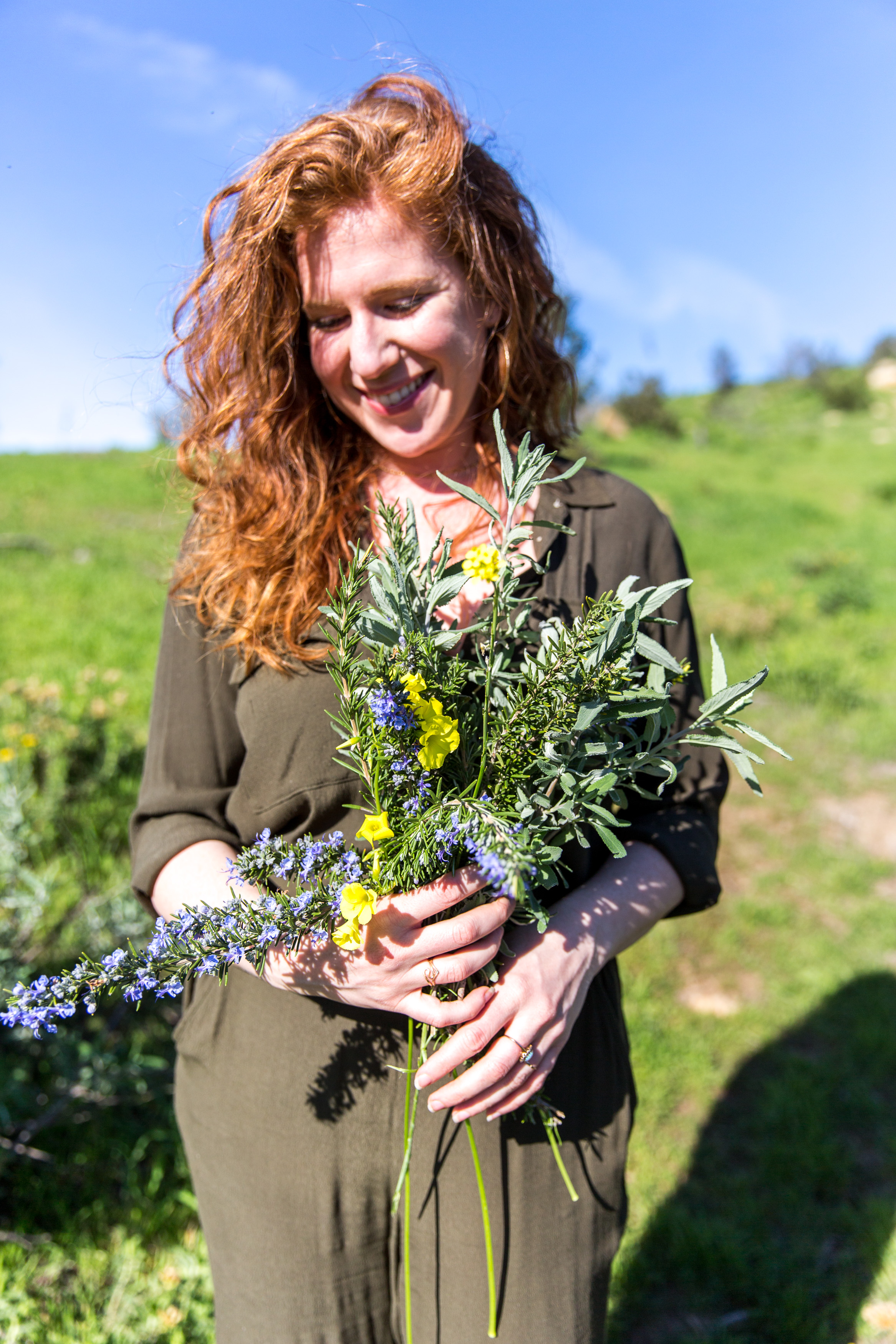
Photos of me above and below, by Marisa Vitale, are on private land where I live—see notes on respectful foraging practices below.
A few weeks ago, I had the privilege of spending an afternoon exploring the native plants of the Santa Monica Mountains with my friend Max Kanter. Max is a walking encyclopedia of flora, particularly when it comes to native California plant life. His ecologically-minded landscape design company, SATURATE, is of constant inspiration to me as I think about what plants to bring into my life and my home.
Eager to breathe in plant life, Max and I took to the hills around my home in Topanga Canyon to explore this distinct plant community. Here’s what I learned.
The Santa Monica Mountains are wildly biodiverse.
Because of the prevalence of microclimates (twelve in total), ranging from coastal salt marsh to chaparral to coast live oak woodland to valley grassland and even cloud forest, thousands of plant species coexist in the Santa Monica Mountains. On any given patch of land, you’re likely to see a mix of invasive grasses and other species brought in by Spanish colonizers in the 1500s, and the native plants that have thrived here for thousands of years.
Under the care of the Tongva and Chumash tribes, native species were cherished as vital elements of life, medicine, community, identity, and cultural practice. Each native species is an integral element of the health of the microclimate and the larger ecosystem. Today, invasive species crowd out many of the native plants, which in turn threatens the wellbeing of the whole plant, animal, and human community—as well as the cultural integrity of these tribes.
Eat the invasives.
Foraging invasive grasses and other edible greens, like mustard—which grows ubiquitously across the United States and causes wildfires to burn hotter and faster—is an easy way to get to know wild plants in your area. If you decide to forage, make sure you do so on land where it’s legal, and to gather with the help of someone who knows how to decipher edible from poisonous plants. Most importantly, it is vital to make sure you are not foraging on land that is private or sacred to indigenous people.
For more information about eating wild plants and invasive species, explore Sunny Savage’s incredible work. Sunny even has a mobile app you can use to find edible wild plants near you.
Also check out this recipe for Roasted Fennel & Spring Greens Soup, which uses foraged mustard greens.

L to R: Native California lupine and native California blue dicks (wild hyacinth)
Some gorgeous native flowers.
Lupine (lupinus albifrons): One of my favorite wildflowers—they cover the hillsides here in Topanga when we’ve had enough rain in the winter for a spring bloom.
Blue Dicks (wild hyacinth, dichelostemma capitatum): Electric blue wild hyacinths. We’re having a blue dicks superbloom this year!
Some beautiful native aromatic herbs.
Purple sage (salvia leucophylla): An aromatic herb known for its silvery leaves, pungent aroma, and potent healing properties. Also edible and lovely for cooking, tinctures, and teas. Flowers in gorgeous purple blooms that smell like honey.
Black sage (salvia mellifera): A sage varietal with a super strong scent, used often in traditional Chumash medicine practice.
Artemisia californica (California sagebrush): My favorite sage-adjacent aromatic—it’s citrusy, minty, and sweeter than the traditional salvias. It’s lovely in food preparations, and was used by the Tongva in a wide array of medicinal treatments, including to alleviate pain and cramping during and prior to menstruation.


L to R: Native California purple sage (salvia leucophylla) and native California sagebrush (artemisia californica).
Some wild native fruits and vines.
Marah (wild cucumber, marah macrocarpu): A wild cucumber that bears fruit excellent for animal consumption, but not super tasty for humans.
Ribes (California currants): A native California currant—I’m excited to try this one once it pollinates and bears fruit.
Plant communities need regular, controlled burns to thrive.
For the past millennia, prior to the arrival of the Spanish, native tribes like the Tongva and the Chumash practiced regular, controlled burns to ensure the strength and safety of the land and its inhabitants. Once the land was widely developed, controlled burns went out of fashion as people were concerned with protecting property and homes.
Thousands of acres of land now go without burning for dozens of years at a time, which means that when wildfires did ignite, there is much more to burn. Fires burn bigger and faster than ever before, because of the amount of kindling and the expanse of land available to burn—and because of rising global temperatures and extreme weather patterns due to climate change.
It would behoove us to consider investing in the infrastructure and technology needed to honor those traditional practices of wildfire protection used by the indigenous people of this land. Controlled burns may be a powerful practice for future safety. Read more here.
Three ways to bring native plants into your life.
Much of our affinity for plants is based on aesthetics, influenced by what we see in the media, on Pinterest, and on other social media platforms. Developing a relationship with native plants means cultivating an understanding of a plant’s distinct purpose, how it supports other plants (and humans), and its unique beauty and seasonality.
Native plants are such a gift. Here’s how you can cultivate that relationship:
- Visit protected, undeveloped lands—state parks, preserves, and other wild areas near you.
- Take note of the native plants growing in this area—many state parks and preserves will provide field guides and placards to help you identify native plants.
- Visit a nearby nursery and ask them to help you select a couple of native plants that might work in your home garden or windowsill planter.
- Develop your relationship with these plants at home, or in your community garden. Research their history and usages. Pay respect to their unique cultural heritage.
To learn more, watch the video of my time with Max.





